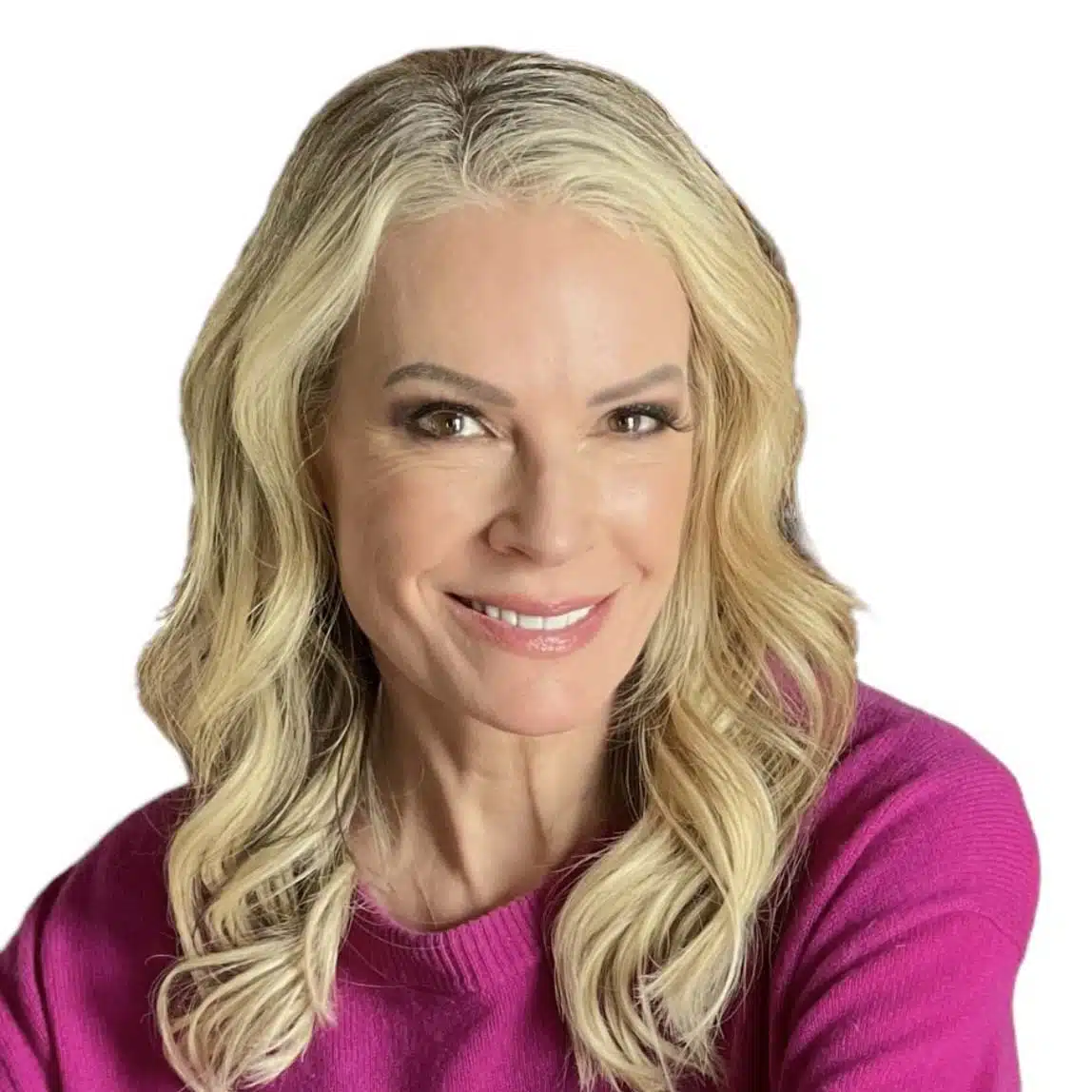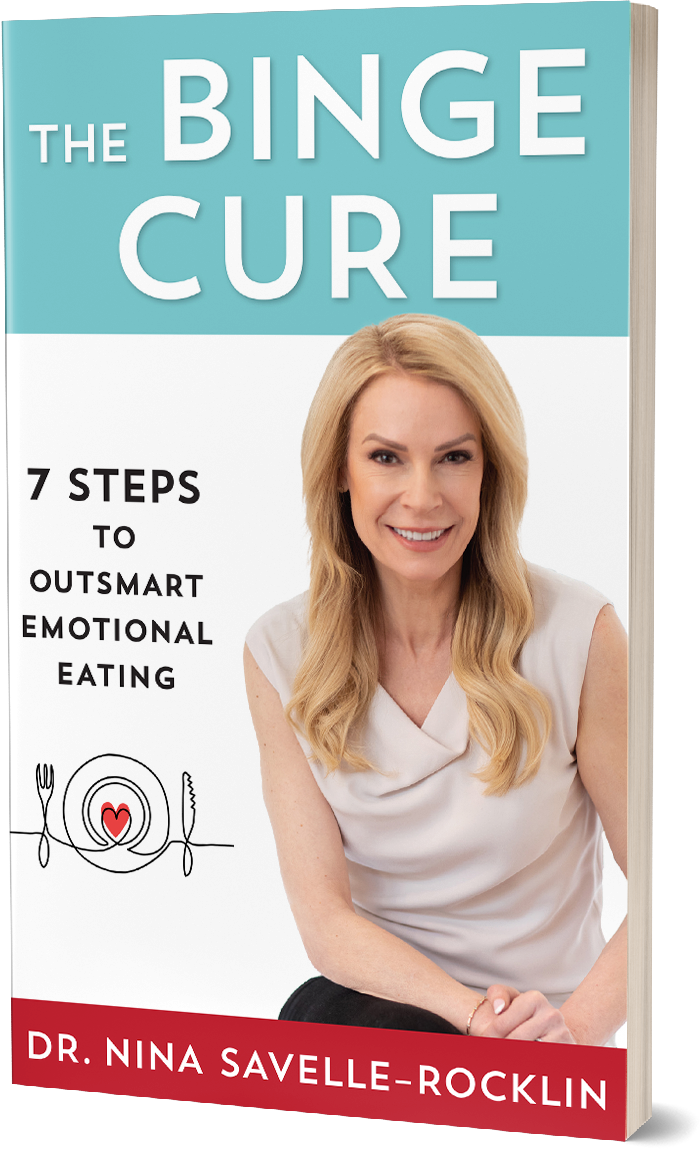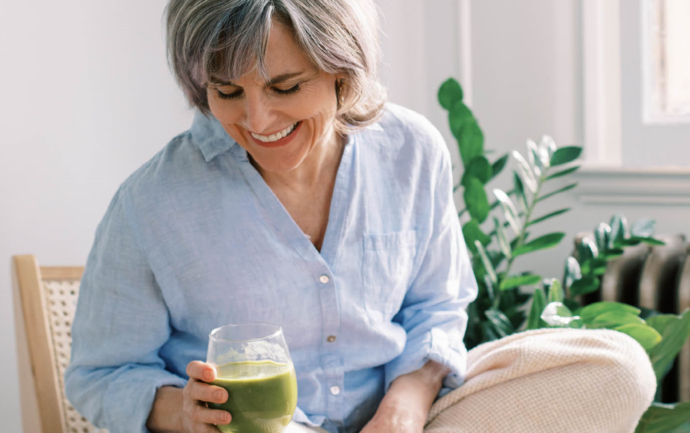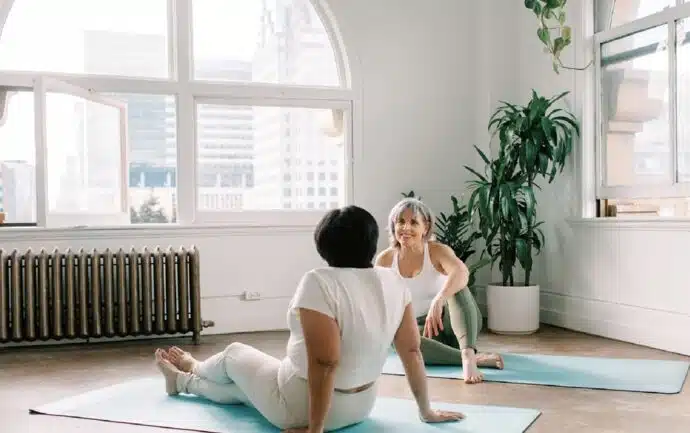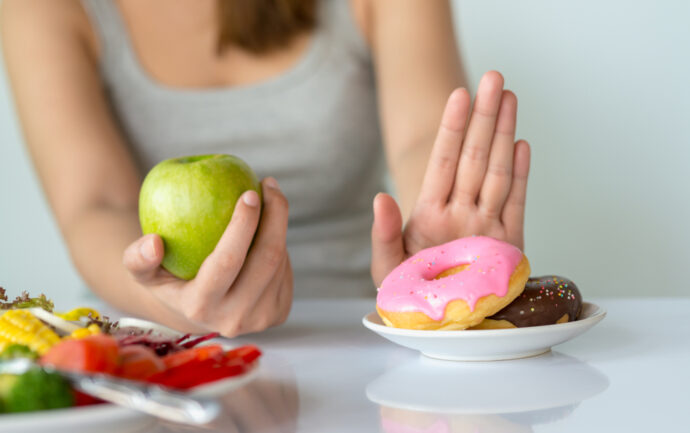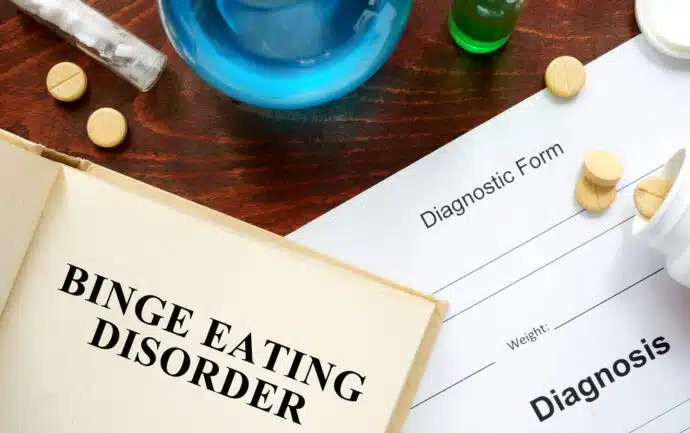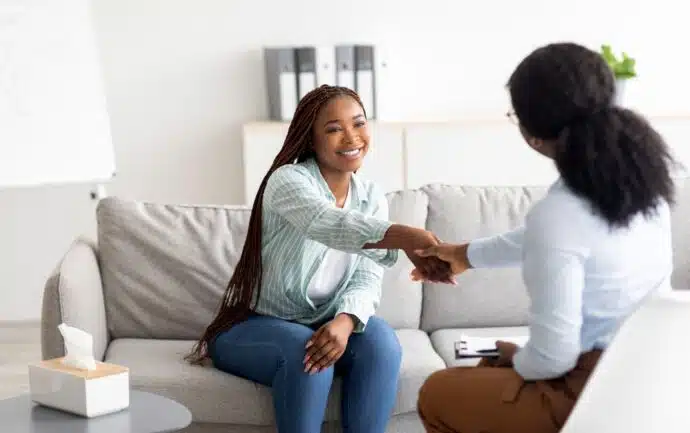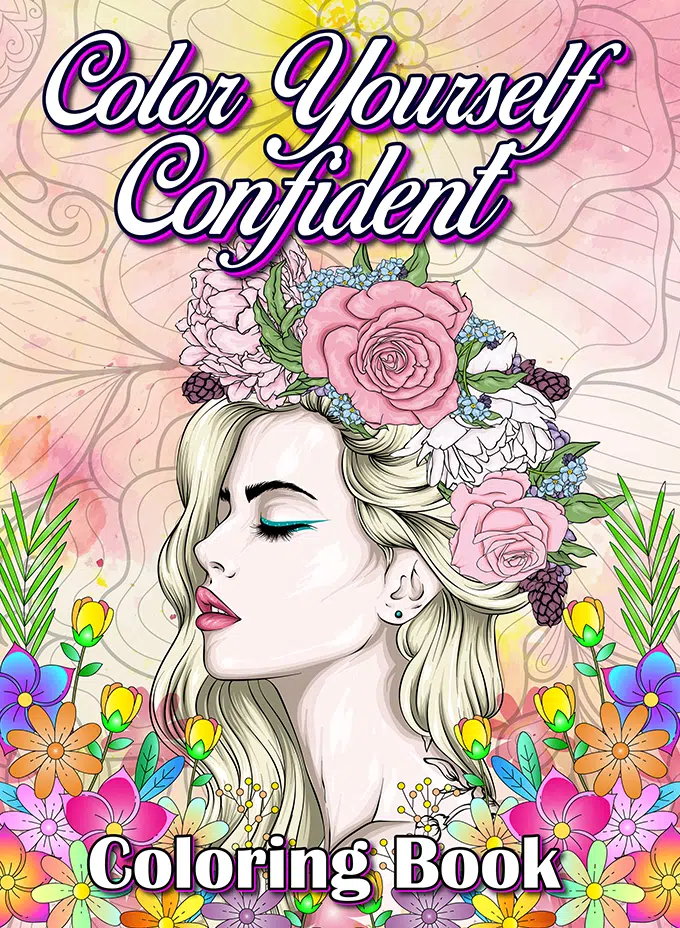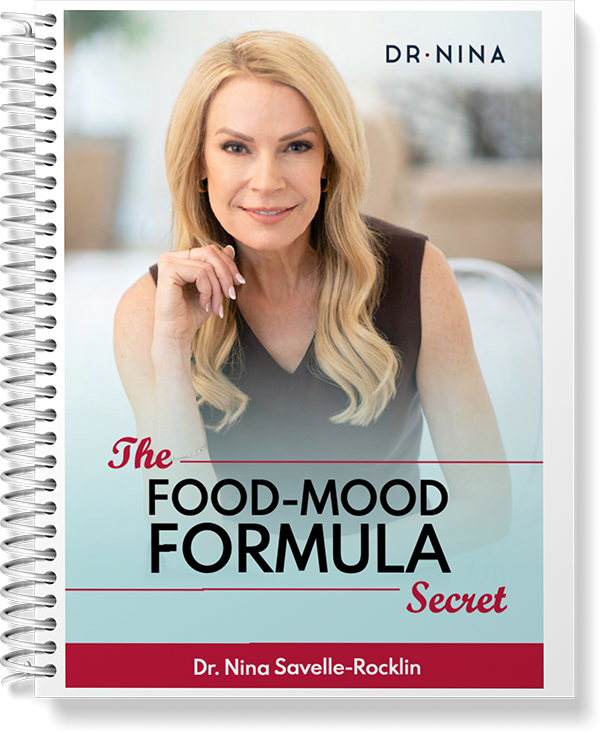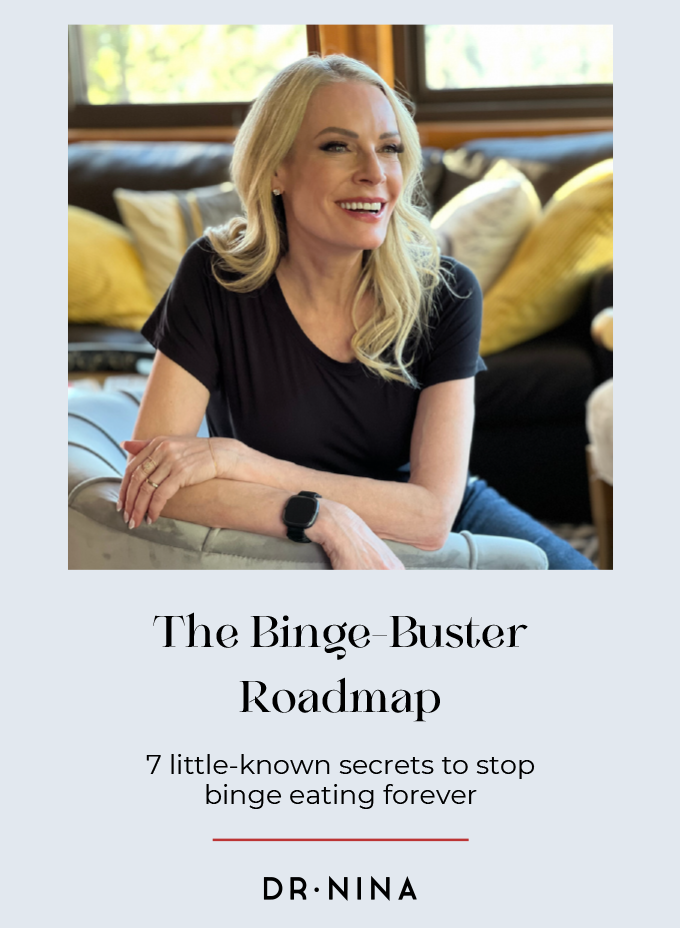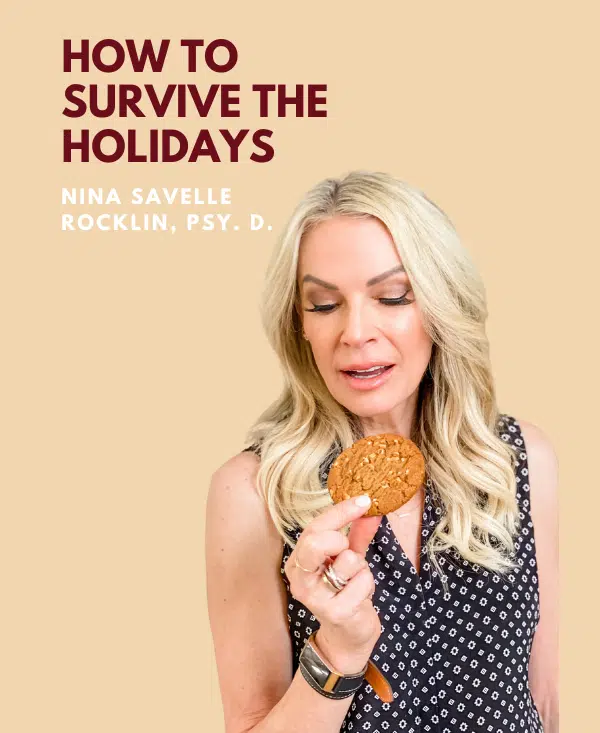Dr. Nina Savelle-Rocklin
10 Powerful Ways to Stop Hating Your Body
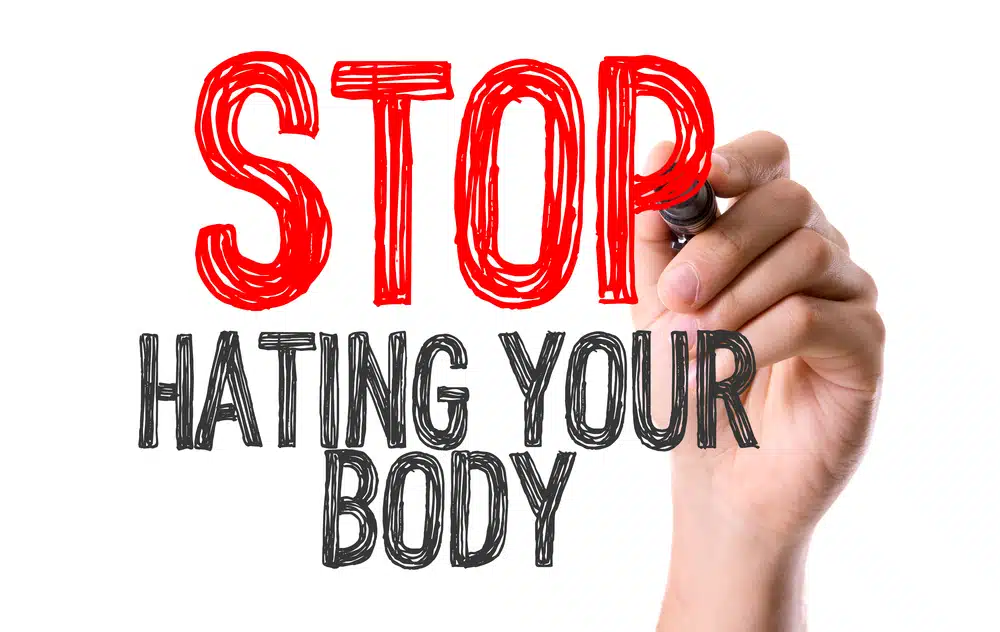
You’ve taken the first bold step towards loving yourself more, which is that you decided to make a change and stop hating your body.
But what’s next? Where do you start?
The journey to accepting your body and cultivating self-love starts from within – that means changing how you perceive your body, embracing your perfectly imperfect self, and respecting your body regardless of societal standards or pressures.
“You yourself, as much as anybody in the entire universe, deserve your love and affection.”
– Buddha
Here are ten techniques that will help you shift from body dissatisfaction to acceptance.
Table of Contents
- 1. Pay Attention to Your Dreams
- 2. Look Back to Your Childhood
- 3. Consider what is weighing on you
- 4. Notice What Sets Off Negative Thoughts
- 5. Heal Old Wounds
- 6. Understand Your Coping Strategies
- 7. Express Hidden Feelings
- 8. Reflect on Your Relationships
- 9. Challenge Long-Held Negative Beliefs
- 10. Stop Hating your Body By Being Kind to Yourself
- Take the First Step Today
- Frequently Asked Questions
1. Pay Attention to Your Dreams
Our dreams offer clues to unconscious conflicts about ourselves. Bella had a recurring nightmare about being offered dried poisonous dates. She recalled the scene in Raiders of the Lost Ark, in which a monkey is poisoned by eating bad dates.
Bella desperately wanted to find a partner but thought she had to lose weight in order to do so. When her body was ready, she reasoned, she would be, too. And yet, she was never happy with her body. Whenever she approached her goal weight, she sabotaged her progress and gained back the weight she’d just lost.
Bella’s dream about the poisonous dates, reminiscent of the movie scene, served as a powerful metaphor for her unconscious fears and conflicts surrounding dating and relationships.
The dream’s symbolism suggested that part of Bella believes that dating, much like the dates in her dream, could be dangerous or harmful. Dating could poison her and kill her.
Bella was in conflict. Part of her desired love and connection and another part of her felt she would lose herself in a relationship.
By never letting herself lose weight and go on a date, she was protecting herself from perceived threats of intimacy and vulnerability in relationships.
Understanding and addressing these unconscious fears and conflicts helped Bella break this cycle, accept herself, and start going on dates without the precondition of changing her body. And, since she no longer associated weight with protection, she was able to lose weight without sabotaging herself.
Our dreams can serve as a window into our subconscious mind, revealing our deepest thoughts and feelings about our lives. Once we recognize these conflicts, we can take active steps to work through them.
2. Look Back to Your Childhood
Think about how your early family life might have influenced the way you feel about your body today. Our body image is shaped during our early years and can carry through to adulthood, impacting how we perceive and feel about our physicality.
Cultural ideals, familial attitudes towards body image, media influence, and personal experiences all contribute to the development of body image.
While you cannot change the past, reflecting on your childhood helps you identify patterns or triggers that influence your view of yourself in the present.
This is about explaining, rather than blaming. For example, Kaitlyn grew up in a family where she always felt like the odd one out. Her parents and siblings were all tall and thin. Kaitlyn was short, with a muscular build that no amount of dieting seemed to change.
As a child, she remembered always feeling different. “Why can’t I be tall and thin like them?” she wondered, and the mirror was a constant reminder of this difference.
While her family never made direct comments about what she looked like, they often made critical observations about other people’s bodies. She absorbed these remarks, internalizing a belief that her body was somehow ‘wrong.’
Kaitlyn did not just come to terms with her height or build; she challenged years of ingrained beliefs and learned to see her body for what it truly was – strong, capable, and uniquely hers.
3. Consider what is weighing on you
Feeling intense emotions and experiencing yourself as ‘too much’ can be a way of displacing intense thoughts and emotions onto your body. Instead of feeling the weight of your emotions, you focus on your weight.
For instance, Emma was often overwhelmed by anxiety that felt like it was just too much to handle. Instead of addressing her anxiety directly, she experienced herself as too big.
Unconsciously, we may do this because it’s easier to focus on losing weight than on processing certain emotions and ideas.
Emma’s feelings of being too much got projected onto her body, which she saw as an extension of her emotional self – too big, too noticeable, too present.
On some level Emma believed that if her body were smaller, less noticeable, she wouldn’t feel such big emotions. This led to her hating her body instead of expressing her true feelings.
By understanding and processing our intense emotions and learning to see them as a natural and manageable part of ourselves, we can break the cycle of negative body image and cultivate a sense of self-love and acceptance.
4. Notice What Sets Off Negative Thoughts
Pay attention to when you feel worse about your body. What’s happening around you? What are you feeling?
Understanding what triggers negative thoughts about oneself is a crucial step towards cultivating self-acceptance and overcoming body image issues.
These triggers vary from person to person. They can be anything from finding yourself in certain situations, such as at a beach, being around people who make you feel uncomfortable, or comparing yourself to others on social media.
Social media constantly exposes us to “perfect” bodies and by extension (or so it seems) perfect lives. This leads to comparison, dissatisfaction, and negative self-perception. It’s important to remember that social media usually presents an idealized version of reality, and comparing yourself to these standards is not healthy or productive.
Sometimes we get in the habit of attacking ourselves as a way of avoiding uncomfortable thoughts and feelings about other people and situations.
For example, whenever Lynn was upset with other people or situations, she deflected by criticizing her appearance. This self-attack became a shield against dealing with the actual issues.
Lynn had a tough relationship with her boss, who often made her feel undervalued. After a meeting where her boss overlooked her suggestions, instead of processing her feelings of frustration towards her boss, Lynn redirected her upset towards her body image. “I’m probably overlooked because of my weight,” she would think, sidestepping the real issue of workplace dynamics.
This pattern was not just confined to her professional life. When a friend unexpectedly canceled on her, Lynn immediately attributed it to her appearance. “I guess I’m not attractive enough to hang out with,” she thought, which avoided her actual feelings of being disappointed in her friend or questioning the friendship’s strength.
By focusing on her weight in these situations, Lynn avoided confronting difficult emotions related to the behavior of others.
This was a way to escape facing potential conflict or admitting that she deserved better treatment and respect. Yet this led to the erosion of her self-esteem and prevented her from addressing the true underlying issues.
5. Heal Old Wounds
Healing old wounds is a crucial step in cultivating self-love, especially when they are tied to body image issues. This requires a deep understanding of your past experiences and how they have shaped your perception of yourself. It’s about acknowledging these past hurts, understanding their impact, and working through them.
Start by identifying the source of these wounds. This could be a specific event, a series of events, or even a general atmosphere or attitude that was prevalent in your past. It could be related to family, friends, or societal pressures. It’s important to be honest with yourself during this process, even if it’s painful.
Incidents of bullying, body shaming, or any form of abuse can leave lasting scars that impact how you perceive yourself and your body.
Once you’ve identified the sources, it’s time to confront them. This doesn’t mean you have to relive the pain, it’s important to process what happened and understand how these experiences affected your self-perception.
Robyn endured emotional abuse in her childhood and developed a protective mechanism using her weight. She believed that by being overweight, she could keep herself safe from further emotional harm.
Her weight became her shield, distancing her from the possibility of close, potentially hurtful relationships.
Food, for Robyn, was a source of comfort and control in a life where she felt neither. It was her response to feelings of loneliness or distress, perpetuating her cycle of weight gain and social withdrawal.
Robyn unraveled the connection between her past abuse, her eating habits, and her body image. Shehe learned healthier ways to cope and when she opened herself to healthier emotional connections, she stopped eating for comfort.
Therapy is a powerful tool in this process. A professional can guide you through your past experiences in a safe and supportive environment, and give you strategies and techniques to cope with your feelings and help you reframe your negative thoughts about yourself.
Healing takes time and patience. By acknowledging and working through your past hurts, you can start to cultivate self-love and embrace your body as it is.
6. Understand Your Coping Strategies
Sometimes we develop habits to protect ourselves, like emotional eating and binge eating. Recognizing these can help you find healthier ways to cope.
Understanding your coping strategies is a crucial step in cultivating self-love, especially when dealing with body image issues.
Coping strategies are behaviors that we adopt to manage stress, anxiety, or discomfort. Some of these strategies, like turning to food, can be harmful and counterproductive in the long run, even though they may provide temporary relief.
Emotional eating is a common coping strategy which involves eating as a response to difficult emotions. It’s not about physical hunger, but an attempt to comfort, soothe, fill an emotional void, or avoid something painful.
Recognizing this pattern is the first step towards finding healthier ways to cope. When you feel the urge to eat due to stress or sadness, try to pause and identify the emotion that’s driving this urge. This awareness can help you find other ways to address these feelings.
Replacing emotional eating with alternatives like yoga or walking, mindfulness practices like meditation, or creative outlets like painting or writing sound good in theory but actually don’t work well in practice.
That’s because emotional eating is a way of escaping your mind, so mindfulness can actually make things worse. The most helpful thing you can do is treat yourself as a friend, giving yourself understanding, compassion, and encouragement when you’re going through a challenge.
7. Express Hidden Feelings
Recognizing and expressing hidden feelings is a crucial step in overcoming body image issues and cultivating self-acceptance. These feelings, often buried deep within us, influence our perception of our bodies.
For example, whenever Marianne felt frustrated or upset, she internalized these emotions and directed her emotions towards her body.
When Marianne had a disagreement with her brother, instead of communicating her feelings or confronting the issue, she’d scrutinize her appearance in the mirror, pinpointing flaws and blaming her body for not being perfect.
“If only I looked different, things would be better,” she’d think, channeling her emotional turmoil into body dissatisfaction.
After a stressful day filled with tight deadlines and unmet expectations, Tom felt overwhelmed. Unable to express his feelings of inadequacy or ask for support, he internalized his stress. Then he’d get mad at himself for not being able to stop ordering pizza and eating too much of it.
In both situations, an inability to express emotions outwardly led them to misdirect their frustrations and unhappiness toward their bodies. This pattern of internalizing emotions and manifesting them as body dissatisfaction is a defense mechanism, a way to avoid confronting and dealing with true feelings.
Identifying disavowed feelings and expressing them in a healthy way through journaling, open conversations, and encouraging self-talk, makes all the difference.
Feelings are just reactions to situations, not character flaws. They don’t define you or your worth. Recognizing and expressing them is a sign of strength and self-awareness, not weakness. It’s a crucial step towards self-love and acceptance.
8. Reflect on Your Relationships
Consider how your connections with others, especially those closest to you, impact how you view yourself.
If we’re constantly around people who criticize their own or others’ appearances, we start to internalize those negative views and apply them to ourselves.
Close relationships, such as family and intimate partners, can also influence our body image. If these relationships involve body shaming or criticism, it can lead to a negative self-image. Conversely, if they encourage body positivity and acceptance, it can foster a healthier self-perception.
Friendships also play a significant role in shaping our body image. People who are always on a diet or disparaging their bodies have an impact on how we see ourselves. Supportive friends who promote body positivity can help us feel more comfortable and accepting of our bodies.
Overall, reflecting on your relationships and their impact on your body image can provide valuable insights into how you view yourself. It can help you identify unhealthy influences and seek out more positive connections. Remember, it’s your body, and you have the right to feel comfortable.
9. Challenge Long-Held Negative Beliefs
Identify any deep-seated negative thoughts about yourself and your body and work on changing these perspectives.
These beliefs often stem from societal standards, past experiences, or negative comments from others, and they can deeply impact how we perceive ourselves.
Start by recognizing these negative beliefs. This could be a belief that you’re not attractive enough, not fit enough, or that your body should look a certain way. Write these beliefs down, as putting them on paper can make them easier to confront and dissect.
Next, question the validity of these beliefs. Ask yourself where they come from. Are they based on facts or are they the result of societal or family pressure or past negative experiences? Consider if you hold other people to the standard to which you hold yourself.
Often, you’ll find that these beliefs are not grounded in reality, but instead in unrealistic standards and expectations.
Once you’ve identified the source of these beliefs, it’s time to challenge them. For every negative belief, try to find a positive counter-belief. For example, if you believe you’re not attractive because you don’t fit a certain beauty standard, counter that with the belief that beauty is subjective and that you’re attractive in your own unique way.
Practicing self-compassion is also key in this process. Treat yourself with the same kindness and understanding you would show a friend. Remind yourself that everyone has flaws and that it’s okay not to be perfect.
10. Stop Hating your Body By Being Kind to Yourself
Being kind involves treating yourself with the same care and understanding you would give to a good friend.
You wouldn’t harshly criticize a friend for their physical appearance or berate them for not meeting certain societal standards of beauty. Instead, you would offer them words of encouragement, support, and love. Similarly, you should extend the same kindness to yourself.
Start by acknowledging your feelings and emotions without judgment. It’s okay to feel insecure or unhappy about certain aspects of your physical appearance. Just don’t let these feelings define your self-worth. Everyone has insecurities, even those who you think have ‘perfect’ bodies.
Be gentle with yourself when you make mistakes or fail, understanding that everyone has flaws and imperfections, and recognizing that these are part of what makes you unique and human.
Another aspect of being kind to yourself is taking care of your physical health. This doesn’t mean striving for a ‘perfect’ body, eating nutritious foods, getting regular exercise and enough sleep. This improves your physical health and has a positive impact on your mental and emotional well-being.
Last, focus on the things you like about yourself that aren’t related to your physical appearance. This could be your kindness, your intelligence, your creativity, your resilience, or any other qualities that make you who you are. By focusing on these positive attributes, you can start to cultivate a sense of self-love that isn’t dependent on how you look.
You’re not only transforming how you view yourself and your body, but you’re also opening the door to a more fulfilling life.
Take the First Step Today
Now that you’ve explored these 10 powerful ways to transform your relationship with your body, I invite you to take the first step on this journey of self-acceptance.
Choose one technique that resonates with you and commit to practicing it this week. Whether it’s acknowledging a negative belief, expressing a hidden feeling, or simply being kinder to yourself, every small step counts.
Join my supportive community, Dr. Nina’s ‘Food for Thought’ Community, where you can share your experiences, gain insights, and find encouragement from others who are walking the same path. Together, let’s embrace the journey of self-love and celebrate every step towards a happier, healthier you.
Start your journey to self-love now. Your future self will thank you.
Frequently Asked Questions
If you’re struggling to stop hating your body, you’re not alone. This is something many of us grapple with, burdening ourselves with constant criticism and negative views of our appearances. Our bodies are unique and they change as we age. Imperfections and variations are not flaws but signs of our unique journey. The key lies in changing your perception toward your body.
Start by appreciating your body for its strength and the marvelous functions it performs every day. This can eventually lead to a shift from body hatred to body appreciation and respect.
1. What if I can't stop negative thoughts about my body?
It’s normal to have negative thoughts occasionally, but consistently negative thinking can harm your self-esteem. Consider seeking professional help that can help you shift these thoughts to a more positive mindset.
2. How can I love myself when others criticize my appearance?
Your self-worth is not determined by external opinions. It’s integral that you cultivate a strong sense of self-appreciation that isn’t influenced by your appearance. Also, consider aspects of your physicality that you do like. By changing our filter to focus on what we do like about our bodies, we are less hard on ourselves.
3. Can I develop self-love if I've always struggled with body image issues?
Absolutely. You learned this way of relating to your body and you can unlearn it and learn a new way of thinking about yourself. With commitment, patience, and practice, you can be at peace with your body and develop an attitude of acceptance and love for yourself.
4. What's the difference between self-love and vanity?
Self-love is about respecting and taking care of oneself while vanity often involves an excessive focus on one’s own appearance. Self-love is about inner wellness and self-acceptance whereas vanity is typically outward-facing.
5. How does self-love impact overall well-being?
Self-love can greatly bolster mental health and overall happiness. It encourages positive self-care habits, resilience, and personal growth. When we love and accept ourselves, we are happier and less concerned with what other people think of us.
Ready to transform your relationship with food?
Join Dr. Nina's newsletter and receive:
• Expert tips on overcoming emotional eating
• Strategies for sustainable weight loss
• Exclusive content not found anywhere else
Don't miss out on the latest breakthroughs in binge eating!
The Author
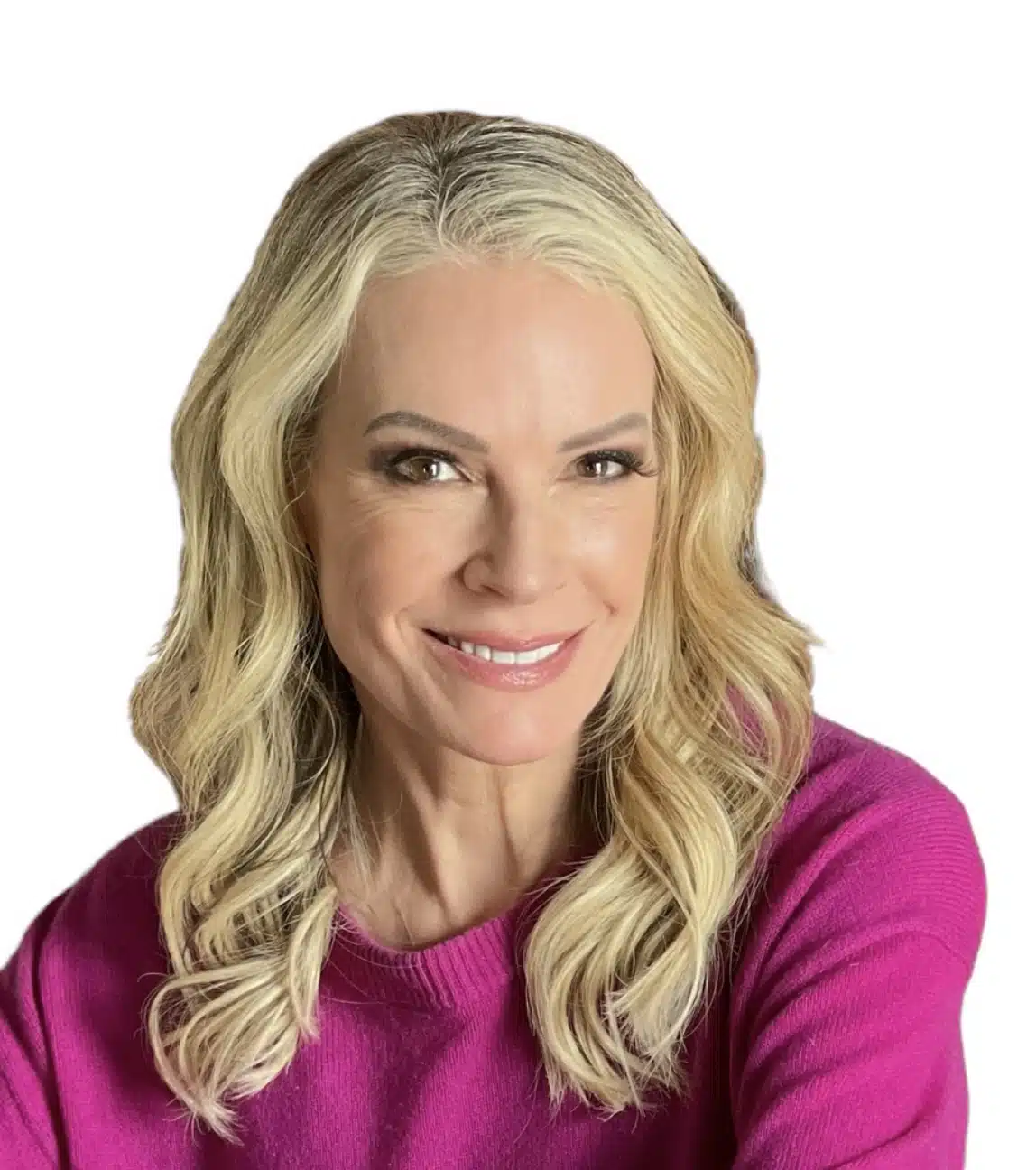
Dr. Nina Savelle-Rocklin is a renowned author and podcast host and one of the nation’s leading psychoanalysts known for the psychology of eating. Her signature message of, “It’s not what you’re eating, it’s what’s eating ‘at’ you” has resonated with hundreds of thousands of listeners from around the globe in 40 countries. As founder of The Binge Cure Method, she guides emotional eaters to create lasting food freedom so they can take back control of their lives and feel good in their bodies.
Related Blogs
